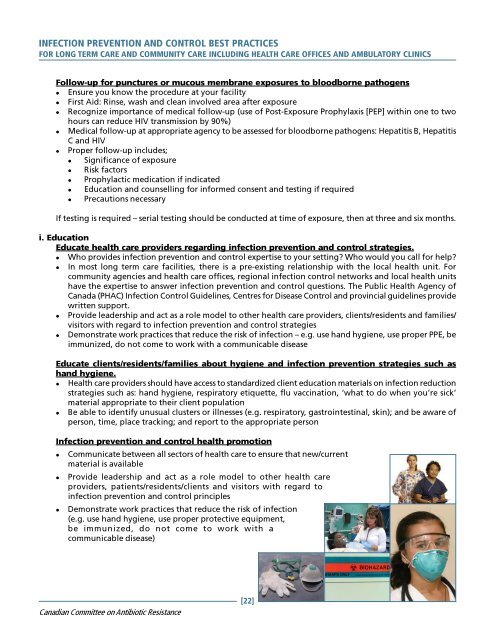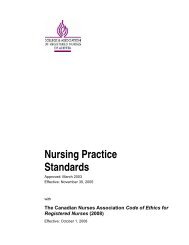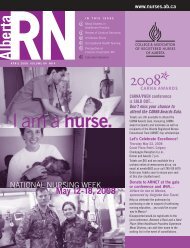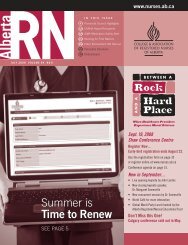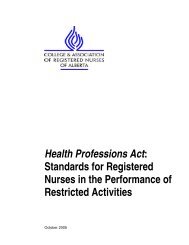Infection Prevention and Control Best Practices - College ...
Infection Prevention and Control Best Practices - College ...
Infection Prevention and Control Best Practices - College ...
You also want an ePaper? Increase the reach of your titles
YUMPU automatically turns print PDFs into web optimized ePapers that Google loves.
INFECTION PREVENTION AND CONTROL BEST PRACTICES<br />
FOR LONG TERM CARE AND COMMUNITY CARE INCLUDING HEALTH CARE OFFICES AND AMBULATORY CLINICS<br />
Follow-up for punctures or mucous membrane exposures to bloodborne pathogens<br />
� Ensure you know the procedure at your facility<br />
� First Aid: Rinse, wash <strong>and</strong> clean involved area after exposure<br />
� Recognize importance of medical follow-up (use of Post-Exposure Prophylaxis [PEP] within one to two<br />
hours can reduce HIV transmission by 90%)<br />
� Medical follow-up at appropriate agency to be assessed for bloodborne pathogens: Hepatitis B, Hepatitis<br />
C <strong>and</strong> HIV<br />
� Proper follow-up includes;<br />
� Significance of exposure<br />
� Risk factors<br />
� Prophylactic medication if indicated<br />
� Education <strong>and</strong> counselling for informed consent <strong>and</strong> testing if required<br />
� Precautions necessary<br />
If testing is required – serial testing should be conducted at time of exposure, then at three <strong>and</strong> six months.<br />
i. Education<br />
Educate health care providers regarding infection prevention <strong>and</strong> control strategies.<br />
� Who provides infection prevention <strong>and</strong> control expertise to your setting? Who would you call for help?<br />
� In most long term care facilities, there is a pre-existing relationship with the local health unit. For<br />
community agencies <strong>and</strong> health care offices, regional infection control networks <strong>and</strong> local health units<br />
have the expertise to answer infection prevention <strong>and</strong> control questions. The Public Health Agency of<br />
Canada (PHAC) <strong>Infection</strong> <strong>Control</strong> Guidelines, Centres for Disease <strong>Control</strong> <strong>and</strong> provincial guidelines provide<br />
written support.<br />
� Provide leadership <strong>and</strong> act as a role model to other health care providers, clients/residents <strong>and</strong> families/<br />
visitors with regard to infection prevention <strong>and</strong> control strategies<br />
� Demonstrate work practices that reduce the risk of infection – e.g. use h<strong>and</strong> hygiene, use proper PPE, be<br />
immunized, do not come to work with a communicable disease<br />
Educate clients/residents/families about hygiene <strong>and</strong> infection prevention strategies such as<br />
h<strong>and</strong> hygiene.<br />
� Health care providers should have access to st<strong>and</strong>ardized client education materials on infection reduction<br />
strategies such as: h<strong>and</strong> hygiene, respiratory etiquette, flu vaccination, ‘what to do when you’re sick’<br />
material appropriate to their client population<br />
� Be able to identify unusual clusters or illnesses (e.g. respiratory, gastrointestinal, skin); <strong>and</strong> be aware of<br />
person, time, place tracking; <strong>and</strong> report to the appropriate person<br />
<strong>Infection</strong> prevention <strong>and</strong> control health promotion<br />
� Communicate between all sectors of health care to ensure that new/current<br />
material is available<br />
� Provide leadership <strong>and</strong> act as a role model to other health care<br />
providers, patients/residents/clients <strong>and</strong> visitors with regard to<br />
infection prevention <strong>and</strong> control principles<br />
� Demonstrate work practices that reduce the risk of infection<br />
(e.g. use h<strong>and</strong> hygiene, use proper protective equipment,<br />
be immunized, do not come to work with a<br />
communicable disease)<br />
Canadian Committee on Antibiotic Resistance<br />
[22]


